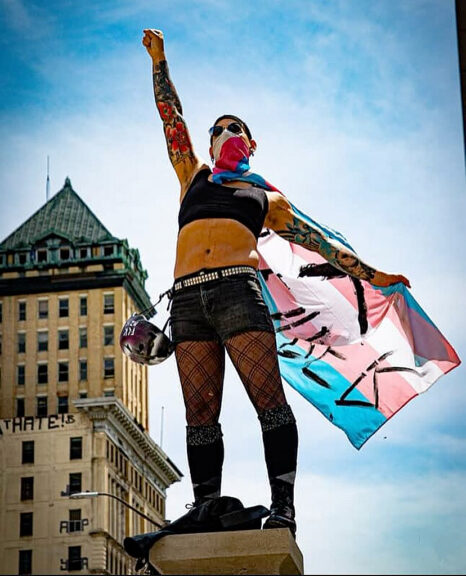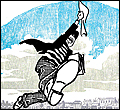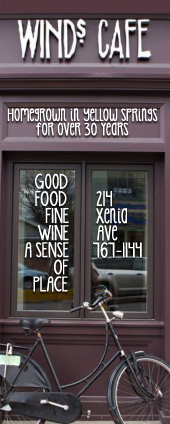Yellow Springs artist fights trans erasure
- Published: June 8, 2025

Local resident and artist Iden Crockett stands in protest against anti-trans measures near the courthouse in downtown Dayton. (Photo by Jen Hunter)
Ohio has passed a surge of anti-trans bills in the last year, encoding in law a ban on gender-affirming care for minors, restricting student bathroom use and banning trans athletes from playing women’s sports. Right after his inauguration, President Trump unleashed a slew of executive orders aimed at gender-nonconforming identities, instructing government agencies to only recognize biological sex and opening doors to move transgender women to men’s prisons, among other actions.
With these imperatives much-discussed in the media and elsewhere, it may seem that trans people have a sort of heightened visibility in the public eye — but it’s often not the kind of visibility that acknowledges their humanity, or the danger that their identities may be erased.
That’s the thinking behind dual projects being launched by local artist and writer Iden Crockett, in the form of an art exhibition and an ongoing collection of narratives written by gender-nonconforming people.
“They have the same goal in mind, and that is just to sort of combat the erasure of trans and gender-nonconforming people,” Crockett told the News this month.
In June — Pride Month — Crockett unveils “Gender X,” an exhibition featuring gender-nonconforming artists, hosted by Bentino’s Pizza. The name of the exhibition refers to one of Trump’s executive orders, which instructed the State Department to remove the “X” option on passports for those who don’t identify as male or female and not to honor requests to change gender markers for trans people.
“That has been sort of like a rallying cry for me personally,” Crockett said. “Since then, I’ve done a lot of things just with that ‘gender X’ phrasing in mind.”
With the “Gender X” exhibition, Crockett said she aims both to add greater gender-nonconforming representation to the village’s local Pride events, but also to increase visibility for these identities in a far-reaching way. She wasn’t sure, though, how great the reach of something like “Gender X” would be if she hosted it in a traditional space.
“Would that help get trans stories and voices into spaces where they aren’t now? Maybe not,” she said. “But if I could put it into public places where people who might not seek out diverse voices would encounter it, then maybe it would.”
Everybody loves pizza, Crockett reasoned — and Bentino’s had recently opened its dining space. It seemed like a good fit.
“Gender X” will feature work by Crockett and fellow Ohio artists Ray Mathew-Santhosham, Dravyn Rosendahl and Lynn Jiminez. Crockett said she found the artists who will be featured through the arts- and activism-based social media network she’s built over the course of several years, and noted that, because she’s a well-known voice for trans issues in the area, she wanted to highlight as little of her own work as possible.
“I don’t have too much of an issue getting my voice out, so I really wanted to see if I could use some of the network I built to help get other voices out, and also show the diversity of the genderqueer community,” she said. “It’s a bright, wide range of people and experiences that that moniker includes.”
Accompanying the art in “Gender X,” photos of and written pieces about each of the artists will be displayed — a component Crockett said is essential to the exhibition’s ultimate goal. She stressed to the artists that their biographies should focus less on accomplishments and more on personal reflection.
“So often at art exhibitions, the bio reads like a resume. I said, “They already know you’re an artist — I want them to know you’re a person,’” Crockett said. “That’s the whole point here — to remind people that trans people are people, they have feelings, and they’re sharing them with you here.”
Crockett said she hopes to continue and expand art exhibitions like “Gender X” in the future in other nontraditional, but high-traffic spaces. What that looks like right now, she said, she’s not sure, but she also hopes that other artists will follow a similar pattern and intention, bringing the art of gender-nonconforming people, and their identities, into contact with a wide variety of people.
In the meantime, Crockett is busy facilitating a project with goals that intersect with, but go beyond the vision for “Gender X.” This year, she began soliciting submissions to the Permanent Ink Project — an initiative that, as its name implies, aims to combat the erasure of gender-nonconforming identities.
Unlike “Gender X,” however, beyond pursuing visibility and understanding for gender-nonconforming people, the Permanent Ink Project is more of a failsafe that hopes for the best, but anticipates the worst.
As Crockett writes on the website for the project, it’s a “doomsday measure to preserve the names and stories of as many genderqueer Americans as is possible. The idea is to collect and disseminate these documents in places where they cannot be accessed and destroyed. Download them and store them in offline hard drives or flash drives, print hard copies and hide them.”
Crockett said the project was inspired while she was thinking about “The Diary of Anne Frank,” a text that has done a lot of heavy lifting over the years to help ensuing generations understand the impact of the Holocaust on its victims. As bill after bill, executive order after executive order came down, it was easy, she said, to draw parallels to her own fears about moving through a world that seems increasingly hostile to trans people.
“And I thought, ‘OK what is the worst case scenario for trans erasure here?’” she said. “It’s literal erasure — the removal of all of our stories and thoughts, the removal of our actual bodies. If trans people face a threat the way minorities did in Germany, at the very least, I want to do something so that our stories can be found and passed forward.”
Crockett has shared the Permanent Ink Project among her own social media circles, and has encouraged others to share it, too. She’s written prompts for those who might need them, and encourages others to “copycat” the project. The goal, she said, is preservation of as many documents as possible.
There have already been submissions to the project — but there’s also been some pushback, she said. People have asked: Is the situation really as bleak as the Permanent Ink Project makes it out to be?
“Maybe we’re not there yet — but if we do get there, it might be too late,” Crockett said. “You know, when you’re driving a car, as you’re crashing is not the time to put your seatbelt on.”
She added: “My attitude is, let’s hope this is a huge waste of time — but we need to act like it’s not, because the people who need to get up and be active to fight against these initiatives are not the ones being affected by them.”
As with “Gender X,” there’s a visibility component to the Permanent Ink Project — not only to the stories of gender-nonconforming folks, but also to the fear many of them feel right now and the danger many of them are in, Crockett said. Awareness of that fear and danger is crucial, she said, for change.
“And becoming aware is what being ‘woke’ means, right?” she said. “Once you are awake and you see and understand, the next step to action isn’t such a far step anymore.”
For more information on the Permanent Ink Project, go to mynameisiden.com/pipinfo.
Contact: chuck@ysnews.com
The Yellow Springs News encourages respectful discussion of this article.
You must login to post a comment.
Don't have a login? Register for a free YSNews.com account.















No comments yet for this article.